Chronic lymphocytic leukemia (CLL) can significantly affect various parts of the body, including the skin. Understanding how this blood cancer impacts your skin health is crucial for early detection of complications and maintaining quality of life during treatment.
As many as 25% of people with CLL experience skin-related symptoms. These manifestations can range from minor issues like rashes to more serious conditions that require immediate medical attention. Learning to recognize these signs can help ensure timely intervention and better health outcomes.
Common Skin Manifestations in CLL
People with chronic lymphocytic leukemia often experience several distinct skin changes that can serve as important indicators of disease progression or complications:
Rashes and Lesions
CLL-related skin rashes typically appear as red or purple patches that may be raised or flat. These can occur anywhere on the body but are most commonly found on the:
- Chest and abdomen
- Arms and legs
- Face and neck
- Back
Bruising and Bleeding
Due to decreased platelet counts, CLL patients often experience:
- Easy bruising from minor bumps
- Petechiae (small red or purple spots)
- Slower healing of cuts and scrapes
- Spontaneous bruising without injury
Understanding Leukemia Cutis
Leukemia cutis is a serious skin manifestation where leukemia cells infiltrate the skin. This condition appears as:
- Raised, firm nodules
- Red or purple plaques
- Varying sizes of lesions
- Most commonly on the face, trunk, and extremities
This condition requires immediate medical attention as it often indicates disease progression and may influence treatment decisions.
Infection Risk and Prevention
CLL compromises the immune system, making patients more susceptible to skin infections. Key prevention strategies include:
- Regular skin inspection
- Proper hygiene practices
- Immediate attention to cuts or scrapes
- Avoiding activities with high risk of skin injury
- Regular use of moisturizers to prevent skin breaks
Treatment Approaches for Skin Complications
Treatment options for CLL-related skin issues vary depending on the specific manifestation:
Topical Treatments
- Corticosteroid creams for inflammation
- Antimicrobial medications for infections
- Moisturizing agents for dry skin
Systemic Treatments
Some skin complications may require systemic treatment approaches, including:
- Targeted therapy for leukemia cutis
- Antibiotics for severe infections
- Modifications to CLL treatment protocol
Skin Cancer Risk and Monitoring
CLL patients have an increased risk of developing skin cancer due to immune system suppression. Regular skin cancer screening and sun protection measures are essential, including:
- Annual dermatological examinations
- Daily sun protection with broad-spectrum SPF
- Protective clothing and hats
- Avoiding peak sun exposure hours
Frequently Asked Questions
What skin symptoms and rashes are most commonly seen in people with chronic lymphocytic leukemia (CLL)? Common skin symptoms in CLL include red or purple rashes, easy bruising, petechiae, and dry, itchy skin. Some patients may also develop nodules or plaques characteristic of leukemia cutis.
How can you tell the difference between leukemia cutis and other skin problems in CLL, and what does leukemia cutis look like? Leukemia cutis typically appears as raised, firm nodules or plaques that are red to purple in color. Unlike common rashes, these lesions tend to be persistent and may grow over time. A biopsy is usually required for definitive diagnosis.
Are skin infections and easy bruising more common in CLL, and how can they be managed or prevented? Yes, both conditions are more common in CLL due to compromised immunity and low platelet counts. Prevention includes good hygiene, prompt wound care, and avoiding injury. Regular monitoring and early intervention for infections are essential.
What types of treatments are available for skin lesions and rashes in chronic lymphocytic leukemia, and how effective are they? Treatments range from topical medications like corticosteroids and antimicrobials to systemic therapies depending on the cause. Treatment effectiveness varies but is generally good when started early and combined with proper CLL management.
Does chronic lymphocytic leukemia increase the risk of developing skin cancer or other serious skin complications? Yes, CLL patients have an increased risk of developing skin cancer due to immune suppression. Regular dermatological monitoring, sun protection, and prompt attention to skin changes are crucial for prevention and early detection.




